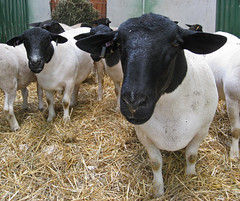In South Africa, genetic improvement in Dorper sheep is based mainly on subjective assessment in the show ring. Information is limited about the genetic relationship between subjectively-assessed and objectively-measured traits, so researchers sought to establish genetic parameters and relationships among these traits.
Single-trait analysis showed live weight and growth traits to be moderately to highly-heritable, ranging from 0.18 +0.04 for post-weaning weight to 0.54 +0.15 for yearling weight. Multi-trait analysis showed weaning weight and average-daily-gain weaning to be of moderate heritability, 0.30 +0.03 and 0.27 +0.03, respectively. Maternal effects were significant, but of low magnitude.
Single and multi-trait analysis determined the heritability of subjectively-assessed traits to be fairly low, 0.07 +0.02 for conformation and type and 0.15 +0.03 for size. Five-trait analyses led to the conclusion that there are some moderate to high maternal genetic correlations as well as dam permanent environmental correlations between live weight, growth, size and type.
While subjectively-assessed and objective measured traits had mainly positive genetic correlations, the researchers concluded that more emphasis should be placed on using objectively-measured traits for breed improvement.
Source: Small Ruminant Research. January 2013.
Read abstract at ScienceDirect.com
 |
| Dorper sheep |
Single and multi-trait analysis determined the heritability of subjectively-assessed traits to be fairly low, 0.07 +0.02 for conformation and type and 0.15 +0.03 for size. Five-trait analyses led to the conclusion that there are some moderate to high maternal genetic correlations as well as dam permanent environmental correlations between live weight, growth, size and type.
While subjectively-assessed and objective measured traits had mainly positive genetic correlations, the researchers concluded that more emphasis should be placed on using objectively-measured traits for breed improvement.
Source: Small Ruminant Research. January 2013.
Read abstract at ScienceDirect.com

1 comment:
Well this looks like very valuable information. Well done to the South African Researchers
Post a Comment